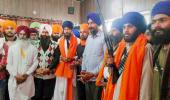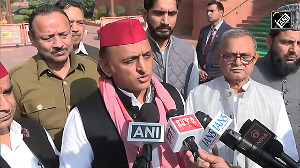Unless Punjab has a chief minister who can look beyond community/vote bank politics, carries all sections of society, stop appeasing while addressing genuine concerns and break the stranglehold of the SGPC over Sikh affairs, my beloved home state is bound to die and conversions will be rampant, warns Sanjeev Nayaar.

Did you know that the founder of the Bahujan Samaj Party founder Kanshi Ram was a Ramdasia Sikh?
He chose to pursue social revolution in Uttar Pradesh (former chief minister Mayawati was his protegee) but not in his home state of Punjab!
Actually, from the time the state of Punjab was formed in 1966, it probably had only two non-Jat chief ministers -- Giani Zail Singh (from the carpenter community of Ramgariya Sikhs) and Charanjit Channi (from the Chamar community of Ramdasia Sikhs). Chamars are followers of Sant Ravidas.
Despite being only about 20% of Punjab's population, against the backward classes of about 30% the Jat Sikhs assume a share of power disproportionate to their population.
Most farmers are Jat Sikhs and thus a big recipient of free power that was introduced by the Akali government in 1997-1998 and central government subsidy.
The powerful Shiromani Gurdwara Prabandhak Community that controls all gurdwaras in undivided Punjab (barring Haryana) is indirectly controlled by the Akali Dal that derives substantial support from Jat Sikhs.
Across parties, every chief minister has to be a Jat Sikh.
One hoped the Aam Aadmi Party would take a different approach but they too succumbed and appointed a Jat chief minister.
The reality is that most chief ministers are focused on the most powerful community in the state.
At the outset I must state that I have nothing against the Jat Sikh community, but some things needs to be explained.
In fact, I admire the 1960s generation for their contribution to the Green Revolution.
This article seeks to provoke thought and not cast aspersions on any community or people.
So the question is, were Jats always so powerful in Punjab?
The answer is, No. The 10 Gurus were Khatris (simply, Kshatriyas). Guru Guru Nanak was a Bedi, Guru Angad a Trehan, Guru Amar Das a Bhalla and the rest were Sodhis.
Jats came into prominence with Maharaja Ranjit Singh's rule.
Further, Jat differences with Bhapas (Khatri-Arora Sikhs) also arise because Jats see themselves as the original followers of the Khalsa (founded by the tenth guru, Guru Gobind Singh, in 1699) as against the Bhapas who were later entrants into the Khalsa.
What they forget is that there were nine gurus before the tenth.
So how did the Jat Sikhs become such a powerful community in Punjab?
Initially, the Khalsa followers were mostly Jats.
Though others considered themselves Sikhs, they held back since they were not followers of the Khalsa.
The birth of the Khalsa resulted in the rise of Jat power in Punjab.
The Khalsa was raised to fight Mughal oppression and persecution of Hindus and Sikhs (who then were considered part of the larger Hindu community).
They got more known with the advent of Maharaja Ranjit Singh's rule and victories against the Afghans.
Further, the British were grateful to the Sikh princes for assistance received during the mutiny of 1857 and seeing the bravery of Sikh armies realised that they could be an effective buffer between Afghanistan and India.
Thereafter, the British made caste the basis of land ownership and tacitly supported the division of Punjab into Sikh and Hindu.
The British wooed the Jats so 'The area specifically chosen for the Sikhs was a tract known as nili bar, irrigated by the Chenab canal. Coloniwation officers scoured Sikh villages in the districts of Amritsar, Ludhiana and Ferozpur to pick up the best farmers. The settlers were given heritable and inalienable rights of occupancy. The vast majority of Sikh colonists were Malwa Jats with a sprinkling on non-Jat agricultural tribes.' (History of Sikhs by Khuswant Singh, Page 118).
A caste divide was created in the Indian Army too. A Jat Sikh regiment and a Sikh Light Infantry for Mazhabi Sikhs were created.
Another reason for rise in their power was that Jats controlled the SGPC since its inception in 1925.
Plus, barring two, every chief minister of Punjab since the state was formed in 1966 has been a Jat Sikh.
Thus, the Jat Sikh community became powerful by virtue of being land owners-farmers, political power and control over Sikh religious affairs.
Another view by Professor Harish Puri is, 'The large scale entry of the Jats by the time of the Sixth Guru, tended to alter the caste equation in the Panth. The Jats constituted the rural elite who dominated the rural Punjab. By the 18th century the Jat constituency was preponderant among the constituent groups in the Panth (McLeod 1975: 10).' (The Scheduled Castes in the Sikh Community - A Historical Perspective by Harish K Puri. [First published in Economic & Political Weekly (June 28, 2003) and was then included in the author's edited volume on Dalits in Regional Context (2004).
Jat Sikhs have disputes, for example, land between themselves, but stand united when a third party is involved as we saw during the farmers' agitation.
They are both nationalists and separatists (biggest proponents of the Khalistan movement).
So what is the present?
The powerful Jat Sikhs have not paid adequate attention to all sections of society.
Thus, a devoted Khatri Sikh laments, "SGPC's definitions of a Sikh make Sehajdharis, Patits and non-Amritdharis second class Sikhs because they are unable to be elected to the SGPC management but are duty bound by its rules and expected to contribute money and labour (sewa)."
A 2016 amendment disentitled Sehajdharis (external link) from voting in the elections of the SGPC and managing committees.
Most agricultural land is owned by Jat Sikhs. Dalits own only 3.5 per cent of Punjab's private farmland, according to the Agriculture Census of 2015-16 (external link).
A lot is made about the rising popularity of Deras that essentially attracts followers from the poorer, backward and non-Jaat sections of society.
In my Rediff.com column Why Dera Sacha Sauda draws followers, I wrote, 'The Green Revolution of the late 1960s benefited Jaats the most as they were the dominant agricultural caste. In the prosperity that followed, the backward classes and poor were left out.
'To add to their woes was the insecurities caused by the extremely violent Khalistan movement of the 1980s. Deras existed earlier too, but the external environment increased the insecurity. The need for a support system and to be part of a larger community was felt.
'It is this vacuum that deras like Sacha Sauda filled. They made the poor feel secure, cared for, loved, provided a support system and gave them dignity.'
Further, the backwards, like Chamars, are not treated well. According to a Punjab-based scholar, "They are considered pariahs in all matters. While Ravidasis take pride in being Chamars (as did their guru), Sikhs continue to consider Chamars as low caste. Inter-dining, inter-marriage between the two communities is still not accepted, although the elite among them enjoys a better social status by virtue of their political or economic power."
Today, when one says Deras are a threat to Sikhism, it means they are a threat to the Akali Dal-controlled SGPC.
The SGPC (that was created to manage gurdwaras in Punjab) has assumed the role of spokesperson of the Sikh Panth.
Thus, the SGPC expresses disapproval of Sant Ravidas or any other living guru, for example the Nirankaris.
The Nirankaris believe in the formless God-Nirankar -- who can be reached through a 'God-realised soul' or 'satguru'.
The cause of differences between orthodox Sikhism and Nirankaris is limited to the latter's worship of gurus other than the 10 gurus recognised by Sikhs.
They also disapprove of the militant Khalsa.
As a Punjabi Khatri, I believe that no current guru should compare himself with the respected 10 gurus.
The Ravidassias, for example, believe in Ravidasia Dharm. It is a Panth, like there have been many in India.
So let us stop assuming that SGPC represents the entire Sikh community.
Unless Punjab has a chief minister who is able to look beyond community/vote bank politics, carry all sections of society, stop appeasing while addressing genuine concerns and break the stranglehold of the SGPC over Sikh affairs, my beloved home state is bound to die and conversions will be rampant.
Punjab needs social reform.
It is the resident Punjabis who have to take the lead, the Centre can only so that much!
A better version of Mayawati needs to rise in Punjab.
Sanjeev Nayyar is founder of esamskriti.com and a chartered accountant.
Feature Presentation: Aslam Hunani/Rediff.com










